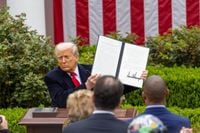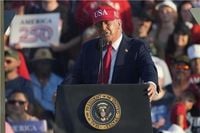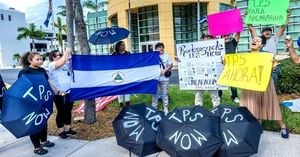On July 7, 2025, U.S. President Donald Trump signed an executive order extending the deadline for the reciprocal tariff waiver until August 1, 2025, effectively granting trade partners, including South Korea and Japan, an additional three weeks to negotiate tariff terms with the United States. This extension follows the original waiver period set to expire on July 8, 2025, which was part of a 90-day suspension enacted on April 9, 2025. The move signals a critical phase of 'final negotiations' amid escalating trade tensions and ongoing efforts to address long-standing trade imbalances.
Trump’s administration had initially imposed reciprocal tariffs on 57 economic entities—including 56 countries and the European Union—on April 2, 2025, with the tariffs scheduled to take effect on April 9. However, the 90-day waiver was granted immediately to allow for negotiations focusing on tariff rates, trade deficits, and the removal of non-tariff barriers. Now, with the extension, these talks will continue past the original deadline, providing more time to potentially resolve disputes.
In a public disclosure that stirred significant attention, Trump posted on his social media platform Truth Social the letters sent to South Korean President Lee Jae-myung and Japanese Prime Minister Shigeru Ishiba. These letters officially notified the two leaders that reciprocal tariffs of 25% would be imposed on their countries’ products exported to the U.S. starting August 1. Trump emphasized that these tariffs are separate from existing item-specific tariffs already in place, such as the 25% on automobiles and 50% on steel and aluminum, but clarified that the reciprocal tariffs would not stack on top of these existing duties.
Specifically concerning South Korea, the letter to President Lee highlighted the persistent trade deficit the U.S. faces, attributing it to South Korea’s tariff and non-tariff policies and trade barriers. Trump wrote, “Our relationship has unfortunately been far from reciprocal. Starting August 1, 2025, we will impose a 25% tariff on all Korean products shipped to the U.S., separate from all item-specific tariffs.” He further warned that products rerouted to avoid tariffs would also be subject to these heightened duties.
However, Trump left room for negotiation, stating that if South Korea opens its previously closed markets to U.S. goods and eliminates its tariff and non-tariff barriers, the tariff rates could be adjusted up or down depending on the evolving relationship between the two nations. “You will never disappoint the United States,” he assured, signaling a willingness to revisit the tariffs based on future cooperation.
From the U.S. White House, Press Secretary Karoline Leavitt confirmed the executive order’s signing and explained that letters detailing reciprocal tariff rates would be dispatched to heads of state in the coming month. She also noted that while letters to South Korea and Japan were publicly released first, letters to 12 other countries would follow shortly. Leavitt clarified that the decision to publicize the letters to these two countries first was at the President’s discretion.
Interestingly, China was excluded from this tariff waiver extension. This exclusion stems from a prior agreement reached between the U.S. and China during high-level talks in Geneva on May 12, 2025, where both sides agreed to significantly reduce their respective tariffs—some exceeding 100%—for 90 days as part of ongoing trade negotiations.
Meanwhile, the South Korean government has responded to these developments with a dual approach. It requested exclusion from a separate U.S. measure imposing port entry fees on vehicle carrier ships built outside the U.S., a policy primarily targeting China but affecting all foreign-built carriers, including those transporting South Korean exports. This measure, set to take effect on October 14, 2025, threatens to raise costs for major exporters like Hyundai Motor, Kia, and their logistics partner Hyundai Glovis.
Regarding the tariff extension, South Korea’s Ministry of Trade, Industry and Energy acknowledged that while the government had engaged fiercely in negotiations since the new administration took office, the time was insufficient to resolve all issues. The Ministry views the letter from President Trump as an effective extension of the reciprocal tariff waiver to August 1 and plans to accelerate negotiations to eliminate uncertainties caused by the tariffs.
The Ministry also expressed intent to leverage this period to advance domestic institutional reforms and regulatory rationalization aimed at addressing the U.S. trade deficit concerns. Furthermore, it plans to deepen manufacturing renaissance partnerships with the U.S., seeking to transform challenges into opportunities for key industries.
President Trump’s broader trade strategy is underscored by his administration’s recent legislative action. On July 4, 2025, he signed the 'One Big Beautiful Bill Act,' a sweeping tax cut measure, signaling an aggressive economic agenda alongside the trade policies.
Trade experts and government officials alike are watching the extended negotiation window closely, recognizing that the upcoming weeks could determine the trajectory of U.S.-Korea trade relations for years to come. The stakes are high, given the intertwined nature of the economies and the potential impact of tariffs on industries ranging from automotive to steel.
While the extension provides a temporary reprieve from immediate tariff impositions, the underlying tensions remain. Trump’s administration has made clear that it views the trade deficit not just as an economic issue but also as a national security concern, emphasizing the urgency of achieving a balanced and reciprocal trade relationship.
As the August 1 deadline approaches, both sides face pressure to reach an agreement that satisfies economic interests without escalating tensions further. Whether South Korea’s efforts to open markets and reduce barriers will be sufficient to sway U.S. tariff policy remains to be seen, but the dialogue is now more critical than ever.





